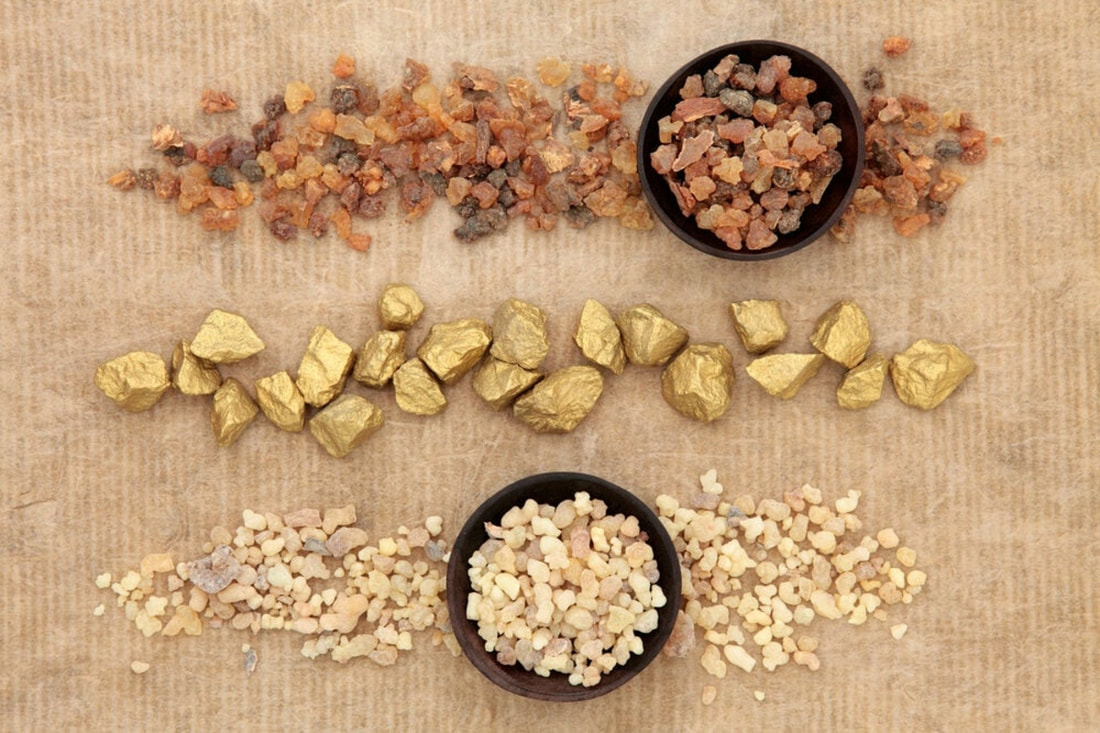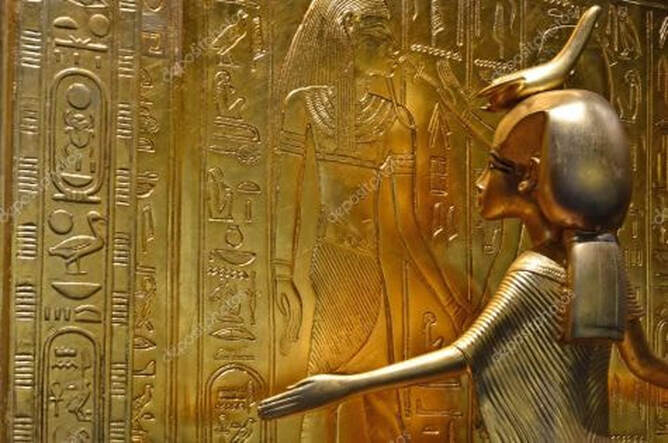|
By Creezy Courtoy, IPF Founder, Perfume Historian and Anthropologist Tracing the Historical Path of Incense, Myrrh and "Gold" As the essence of Christmas envelops us, the shimmering allure of gold intertwines with ancient trade routes and the symbolic journey of the Three Kings. Egypt's pursuit of incense, myrrh, and oud through the exchange of gold highlights the interconnectedness of cultures and the quest for precious treasures. Together, let us embrace the universal values of peace and unity, inspired by the story of the Three Kings, the timeless significance of gold in our celebrations and the spirit of peace. The Magnificence of Incense, Myrrh, and Oud During antiquity, Egypt was known for its rich trade connections and its desire for valuable commodities, including incense, myrrh, and agarwood. These aromatic substances held significant cultural and religious importance in ancient Egypt, and they were highly sought after for their fragrance and other perceived qualities. The fragrant smoke of incense was believed to carry prayers and offerings to the heavens. Myrrh, used in embalming and as a sacred offering, symbolized purification and spiritual connection. Oud, with its captivating aroma, was a prized ingredient in perfumery and incense-making. Egypt, renowned for its opulence and reverence for these aromatic substances, sought to obtain them from regions along the Perfume Roads. Incense: Incense was widely used in religious rituals, offerings, and ceremonies in ancient Egypt. It was believed to possess purifying and protective properties, and its fragrant smoke was thought to carry prayers and offerings to the gods. To obtain these sought-after varieties, Egypt had to engage in trade with regions like Arabia and the Horn of Africa, where these substances were produced. Myrrh: Myrrh, another aromatic resin, held religious and medicinal significance in ancient Egypt. It was used in embalming practices and as an offering to deities. Egypt's access to myrrh was limited, as it primarily came from regions like present-day Somalia, Ethiopia, and Yemen. Agarwood (Oudh): Agarwood, also known as oudh, is a fragrant wood derived from the Aquilaria tree. It has a rich, woody aroma and is highly valued in perfumery and incense-making. Agarwood was sourced from regions such as Southeast Asia and the Indian subcontinent. Egypt's Trade: Gold for Precious Fragrances The acquisition of these precious substances, however, often required the exchange of large quantities of gold due to their scarcity and demand. Gold, which was highly valued, served as a medium of exchange in international trade. As caravans traversed desert landscapes, laden with gold, they ventured towards regions like Arabia, the Horn of Africa, and the Indian subcontinent. Egypt's desire for incense, myrrh, and oud drove the trade of this precious metal, forging connections and fostering cultural exchange along the ancient trade routes. Gold mining, both in Egypt and through trade with neighboring regions, was a significant source of wealth for the ancient Egyptians. Egypt's abundance of gold during antiquity can be attributed to several factors, including its geographical location, natural resources, and historical developments. Egypt had its own gold deposits, primarily located in the Eastern Desert, near the Red Sea. Ancient Egyptians developed mining techniques to extract gold from these deposits. They employed methods such as panning, sluicing, and tunneling to access the gold-bearing ore. Egypt's location in northeastern Africa placed it in proximity to gold-rich regions, such as Nubia (present-day Sudan) and the Eastern Desert. Nubia, located to the south of Egypt, was particularly renowned for its gold mines. The Nubian region had significant gold deposits, including alluvial gold found in riverbeds and veins of gold embedded in rocks. Gold held immense economic value in ancient Egypt. It was widely used as a medium of exchange, a store of value, and a symbol of wealth. Gold was employed for various purposes, including trade, religious offerings, ornamental and luxury items, and the adornment of pharaohs and temples. The demand for gold, both domestically and internationally, contributed to its importance as a form of wealth for Egypt. Additionally, Egypt was able to acquire gold as tribute or payment from conquered territories or through diplomatic relations with neighboring regions. Gold held deep cultural and religious significance for the ancient Egyptians. It was associated with the sun god Ra and was considered a symbol of divine power and eternal life. Gold was used in religious rituals, temple construction, and burial practices, indicating its importance beyond its economic value. These factors combined to make Egypt a significant center for gold acquisition and accumulation during antiquity. Egypt's control over gold mining, its trade connections, and its cultural reverence for gold allowed it to amass substantial wealth in the form of this precious metal. The Journey of the Three Kings The Three Kings are believed to have originated from different regions of the ancient world. Melchior, often depicted as an elderly Persian scholar, hailed from Persia (modern-day Iran). Balthazar, portrayed as an African or Arabian nobleman, is thought to have come from Sheba or Arabia Felix (present-day Yemen). Lastly, Gaspar, a youthful figure, was said to have hailed from Saba (modern-day Ethiopia or Sudan). The Three Kings carried precious gifts symbolizing their reverence and respect for the newborn baby. These gifts were not only symbolic but held great value during the time. Beyond their biblical narrative, the journey of the Three Kings holds historical significance. It reflects the ancient trade routes that connected civilizations, the cultural exchanges that took place, and the role of Arabia as a center of commerce and knowledge. The gifts the Kings presented also highlight the importance of incense, myrrh, and gold in ancient societies. To reach their destination, the Three Kings embarked on a perilous journey across the vast Arabian Desert. This desert, with its shifting sands and treacherous terrain, presented numerous challenges. The exact route they took remains a subject of speculation, but historical evidence suggests they likely followed ancient trade routes and oasis trails, navigating by the stars and their knowledge of the desert. The Path through the Arabian Desert
From Persia to Arabia: Melchior, the Persian king, set out from his homeland, traversing arid plains and rugged mountains. His journey took him through the ancient cities of Persis, Parthia, and the Arabian Peninsula, eventually leading him towards the southern Arabian region. Melchior presented gold, representing kingship and wealth. From Saba to Arabia Felix: Balthazar, originating from the Kingdom of Saba, embarked on his expedition from the southwestern Arabian Peninsula. He embarked on a challenging trek through the deserts of Yemen, navigating the arid landscapes and ancient trade routes that connected the region with the rest of the world. Balthazar offered frankincense, a fragrant resin used in religious rituals, symbolizing divinity. From Saba to the Land of the Nile: Gaspar, the youngest of the Three Kings, hailed from the Kingdom of Saba. He embarked on his journey, traveling northward, along the Red Sea coast. Crossing vast stretches of desert, he eventually reached the ancient land of the Nile, making his way to the heart of Egypt. Gaspar bestowed myrrh, an aromatic resin used in embalming, symbolizing mortality and sacrifice. Gold or Liquid Gold? While Melchior is traditionally associated with offering gold, it is intriguing to explore the symbolic connection between gold and oudh or agarwood, the most precious scent in Arabia, often referred to as "liquid gold." Gold has long been associated with wealth, luxury, and kingship in various cultures. In the context of the Three Kings' story, Melchior's gift of gold symbolizes the recognition of the newborn baby's royal status and the acknowledgement of his future as a great ruler. In addition to its material value, gold also represents purity and divinity. Its shimmering brilliance has often been associated with the divine presence and elevated spiritual significance. Similarly, oudh or agarwood holds a special place in Arabian culture and has been treasured for centuries for its exquisite fragrance and rarity. Oudh is derived from the resinous heartwood of the agar tree, primarily found in Southeast Asia, India, and the Arabian Peninsula. It is a highly sought-after fragrance ingredient, renowned for its rich, complex aroma, often described as woody, balsamic, and captivating. The extraction process of oudh is meticulous and time-consuming, contributing to its high value. The term "gold" used to describe oudh or agarwood in the context of the Three Kings' gifts signifies its extraordinary worth and significance. Oudh is considered a precious treasure, a symbolic representation of luxury, spirituality, and devotion. Just as gold is associated with kingship, oudh is associated with nobility and opulence in Arabian culture. It is important to note that while the inclusion of oudh as "gold" in the Three Kings' story may have cultural significance and symbolism, it is not a historical fact but rather a poetic interpretation that enriches the narrative and adds to its allure. The inclusion of oudh as a symbolic representation of gold in some interpretations of the story is a way to add cultural richness and depth to the narrative. It draws upon the significance of oudh in Arabian culture and its association with luxury and opulence. The Symbolic Journey of the Three Kings, a desire for peace, harmony: The biblical tale of the Three Kings, or Wise Men, embarking on a journey across the desert to present gifts to the infant Jesus in Jerusalem, encapsulates the spirit of peace and harmony among the three Abrahamic religions. Symbolizing Judaism, Christianity, and Islam, the Three Kings epitomize the unity and shared reverence for the divine. The gifts they brought signify not only material wealth but also spiritual devotion and the pursuit of peace. Their passage through the desert echoes the importance of pilgrimage and the pursuit of spiritual enlightenment. The exchange of these precious gifts symbolizes a desire for peace, harmony, and the recognition of the divine presence within humanity.
0 Comments
By Creezy Courtoy, IPF Founder and Chair and Perfume Anthropologist Understanding Scent Preferences for Creating and Distributing Fragrances Distributing a perfume in several countries can be a real challenge. It can be just a failure for famous brands, but a dangerous game for small brands who can financially lose everything. In the art of fragrance creation, understanding the anthropology of perfume is essential. By delving into the diverse scent preferences shaped by culture, region, and individual sensitivities, fragrance creators can craft scents that resonate on a deeper level. The ability to influence others through the strategic use of preferred scents becomes more attainable when armed with the knowledge of anthropology of perfume. So, let's embrace the rich tapestry of scent preferences and create fragrances that captivate the senses and forge lasting connections. Men and women have long recognized the power of scents in influencing their fellow humans. While it is impossible to predict exactly how an individual will respond to a particular smell, psychologists have discovered intriguing connections between odors and memories. For example, a single floral scent can evoke memories of a crowded elevator, a funeral, an old boyfriend's excessive aftershave, or even the onset of hay fever. Despite the varying responses, scientific investigations have revealed common preferences among sexes, cultures, age groups, and personality types. By understanding these preferences, perfumers can safely select the countries where their products will be successful. Cultural Influences on Scent Preferences Cultures play a significant role in shaping scent preferences and the ways in which scents are used. Let's explore some fascinating examples: The Japanese: Perfuming Daily Life
In Japanese culture, scent has permeated almost every aspect of daily life. From personal care products to household items, the Japanese have cultivated a deep appreciation for fragrance. They even engage in games with friends and family that involve identifying various smells. Understanding the importance of scent in Japanese culture can provide valuable insights when creating fragrances for this audience. In contrast, the Anglo-Saxon approach to scent is more understated. Publicly smelling one's food or wine is considered uncouth in their culture. However, the bouquet of wine and the taste of food both heavily rely on the sense of smell. Anglo-Saxons prefer subtler scents when it comes to personal fragrance, avoiding being too "obvious." Respect for cultural norms is crucial when designing fragrances for this audience. Across different cultures, there are notable variations in scent preferences. For instance, Orientals appreciate heavy, spicy, and animalistic perfumes. Valerian root extract, which is detested by most Europeans, is favored in Oriental cultures. On the other hand, Asians may struggle to understand the Western love for pungent cheeses. Recognizing these cultural differences is essential for creating fragrances that resonate with specific target markets. Regional Influences on Fragrance Choices Apart from cultural influences, regional factors such as climate and environment also shape fragrance preferences. Northern Europeans, living in colder climates, often prefer heavier fragrances that provide warmth and comfort. In contrast, Mediterraneans are drawn to sophisticated floral scents, likely due to their love for being surrounded by flowers. Taking these climate-based preferences into account can enhance the effectiveness of fragrance creations. Universally Pleasant Smells and Aversions While there are cultural and regional variations, it is safe to say that there is a broad agreement within the human race about what smells pleasant and what doesn't. Most people appreciate flower and fruit scents, while being repulsed by foul odors such as rotten eggs, fish, or stagnant drains. Understanding these universally pleasant and unpleasant smells can guide fragrance creators in developing appealing and attractive scents. People's responses to scents can also vary based on their individual sensitivities, as well as the influence of education, societies, and marketing. Therefore, do not miss your opportunity to sell and distribute successfully your perfumes worldwide. Learn more about the Anthropology of Perfume and get ready for your perfume distribution. |
Archives
March 2024
Categories
All
|
- Home
- About
- Why choosing us
- Mission
- Academicians
- IPF Certification
-
COURSES
-
MASTER CLASSES
- Teaching Methodology
- Natural Raw Material Extraction Methods >
- Natural Candle Making
- Healing Gardening
- Sustainable Oud MasterClass
- World Perfume History Master Class
- Scent Design and Formula Building >
- Fragrant Botany & Chemistry >
- Perfume Design, Concept and Storytelling
- French Natural Aromachology #1
- French Natural Aromachology #2
- Olfaction Training for Children
- Accords - Musks
- Accords - Chypre
- Accords - White Florals 1
- Accords - Fougeres and Aromatics
- FRAGRANCE DEVELOPMENT
- SPEAKERS
- EXHIBITIONS
- Partners
- Blog
- Contact








 RSS Feed
RSS Feed
